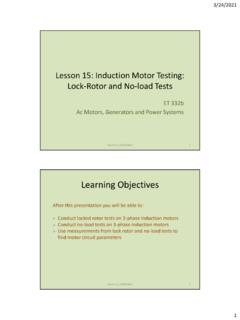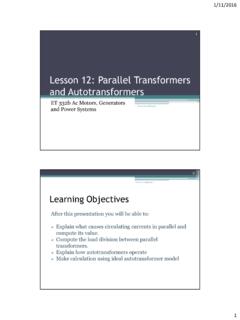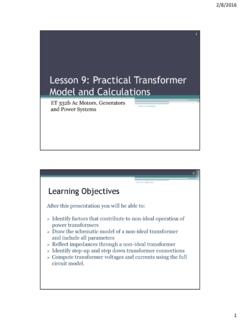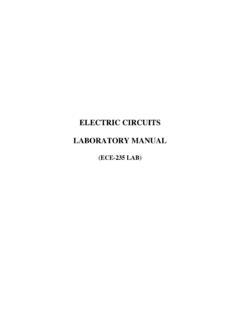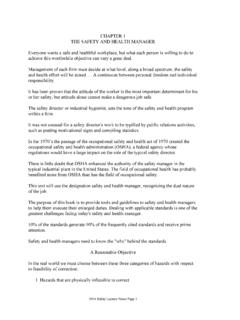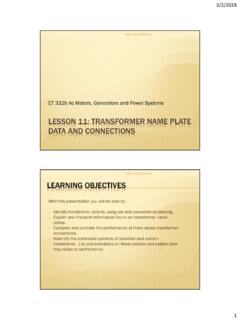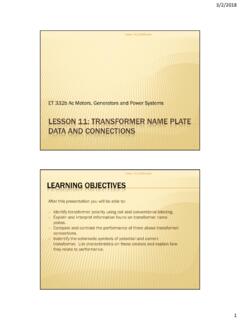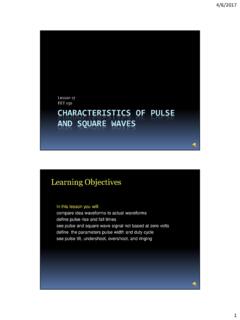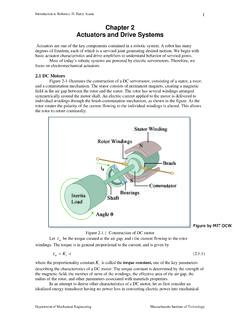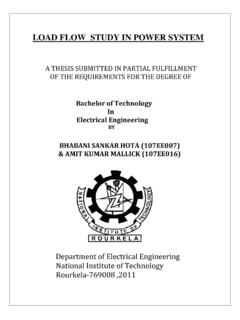Transcription of Lesson 14: Transfer Functions of Dc Motors
1 10/28/2015 1 Lesson 14: Transfer Functions OF DC Motors ET 438a Automatic Control Systems Technology 1 LEARNING OBJECTIVES 2 After this presentation you will be able to: Write the Transfer function for an armature controlled dc motor. Write a Transfer function for a dc motor that relates input voltage to shaft position. Represent a mechanical load using a mathematical model. Explain how negative feedback affects dc motor performance. 10/28/2015 2 STEADY-STATE OPERATION OF SEPARATELY EXCITED DC Motors 3 Consider steady-state model wm ia = armature current eb= back emf ea= armature terminal voltage wm = motor speed (rad/sec)
2 T = motor torque Tf = static friction torque Ra = armature resistance La = armature inductance Jm = rotational inertia Bm = viscous friction Review the steady-state relationships Of machine STEADY-STATE OPERATION OF SEPARATELY EXCITED DC Motors 4 Relationships of Separately Excited Dc Motor ia T -Tf DT Dia KT=DT/Dia Torque-Current Curve Back EMF Curve wm eb DT Dia KT=DT/Dia Speed-Torque Curve T wm DT Dwm wm=wnl (Dwm/DT)T wnl 10/28/2015 3 STEADY-STATE MOTOR EQUATIONS 5 Developed Torque m-N TiKTfaT =T = motor torque KT = torque constant Tf = motor friction torque ia = armature current KVL in Armature Circuit V eRiebaaa =wm= shaft speed (rad/s) eb = back emf Ke = back emf constant Back EMF V Kemebw =Developed Power WTPm w=ea= armature voltage eb = back emf Ra = armature resistance P = shaft power 6 STEADY-STATE MOTOR EQUATIONS Combining the previous equations gives.
3 ETafaTmKKR)TT(eK =weaaamKRie =wIf the load torque is zero (T=0) then the above equation (1) gives the no- load speed (1) (2) eTafaTnlKKR)T(eK =w10/28/2015 4 STEADY-STATE MOTOR OPERATION 7 Example 14-1: An armature-controlled dc motor has the following ratings: Tf= N-m, Ra= ohms, KT= N-m/A, Ke= V-s/rad. It has a maximum speed of 500 rad/s with a maximum current of 2 A. Find: a) maximum output torque, b) maximum mechanical output power, c) maximum armature voltage, d) no- load speed at maximum armature voltage. EXAMPLE 14-1 SOLUTION (1) 8 Define given variables a) Tmax occurs at Imax Answer b) Find Pmax Answer 10/28/2015 5 EXAMPLE 14-1 SOLUTION (2) 9 c) Find maximum back emf Answer d) Find no- load motor speed At no- load , T=0.
4 load torque is zero. T=0 Transfer FUNCTION OF ARMATURE-CONTROLLED DC MOTOR 10 Write all variables as time Functions JmBmLaT(t)eb(t)ia(t)ea(t)++RaWrite electrical equations and mechanical equations. Use the electromechanical relationships to couple the two equations. Consider ea(t) and eb(t) as inputs and ia(t) as output. Write KVL around armature =)t(ea )t(iRaadt)t(diLa )t(eb Mechanical Dynamics )t(Bdt)t(dJ)t(Tmmmmw w =10/28/2015 6 Transfer FUNCTION OF ARMATURE-CONTROLLED DC MOTOR 11 Electromechanical equations )t(iK)t(T)t(K)t(eaTmEb =w =Find the Transfer function between armature voltage and motor speed ?
5 S(E)s(am= Take Laplace transform of equations and write in I/O form )s(E)s(ERsL1)s(I)s(I)RsL()s(E)s(E)s(E)s( I)RsL()s(E)s(E)s(IR)s(IsL)s(Ebaaaaababaa abaaaa = = = = Transfer FUNCTION OF ARMATURE-CONTROLLED DC MOTOR 12 )s(IK)s(T)s(K)s(EaEmEb = =Laplace Transform of Electromechanical Equations )s(B)s(sJ)s(Tmmmm =Laplace Transform of Mechanical System Dynamics )t(Bdt)t(dJ)t(Tmmmmw w =Rewrite mechanical equation as I/O equation sTBsJ1s sBsJsTmmmmmm = =10/28/2015 7 BLOCK DIAGRAM OF ARMATURE-CONTROLLED DC MOTOR 13 Draw block diagram from the following equations )s(E)s(ERsL1)s(Ibaaa =1/(Las+Ra) Ea(s) Ia(s) + - KT Eb(s) )s(IK)s(TaT =1/(Jms+Bm) T(s) sTBsJ1smmm = m(s) )s(K)s(EmEb =Ke Note: The dc motor has an inherent feedback from the CEMF.)
6 This can improve system stability by adding a electromechanical damping Transfer FUNCTION OF ARMATURE-CONTROLLED DC MOTOR 14 Use the feedback formula to reduce the block diagram sHsG1sG)s(Esam = EK)s(H=G(s) is the product of all the blocks in the forward path 1/(Las+Ra) KT 1/(Jms+Bm) mmaaTmmaaTBsJRsLKBsJ1 RsL1 KsG = =10/28/2015 8 SIMPLIFICATION OF Transfer FUNCTION 15 EmmaaTmmaaTamKBsJRsLK1 BsJRsLK)s(Es = Substitute G(s) and H(s) into the feedback formula G(s) G(s) H(s) Simplify by multiplying numerator and denominator by factors (Las+Ra)(Jms+Bm) ETmmaaTamKKBsJRsLK)s(Es = Expand factors and collect like terms of s )BRKK(s)LBJR(sJLK)s(EsmaETamma2maTam = Final Formula Roots of denominator effected by values of parameters.
7 Can be Imaginary. DC MOTOR POSITION Transfer FUNCTION 16 Motor shaft position is the integral of the motor velocity with respect to time. To find shaft position, integrate velocity )t(dt )t(dt dt)t(d)t(dt)t(d =w= w= To find the motor shaft position with respect to armature voltage, reduce the following block diagram 1/(Las+Ra) Ea(s) Ia(s) + - KT Eb(s) 1/(Jms+Bm) T(s) m(s) Ke 1/s Qm(s) 10/28/2015 9 DC MOTOR POSITION Transfer FUNCTION 17 sBRKKsJRBLsJLK)s(E)s()BRKKsJRBLsJL(sK)s( E)s(BRKKsJRBLsJLKs1)s(E)s(maET2mama3mmTa mmaETmama2mmTammaETmama2mmTam =Q =Q = Position found by multiplying speed by 1/s (integration in time) )s(s1)s(mm =QREDUCED ORDER MODEL 18 Electrical time constant is much smaller than mechanical time constant.
8 Usually neglected. Reduced Transfer function Define motor time constants eaammmRL and BJ = =Where: m = mechanical time constant e = electrical time constant maETmasmaETTsssamBRKKJR and BRKKKK Where s1K)s(E)s( = = = 10/28/2015 10 MOTOR WITH load 19 Consider a motor with load connected through a speed reducer. load inertia = JL load viscous friction = BL Motor coupled to speed reducer, motor shaft coupled to smaller gear with N1 teeth. load connected to larger gear with N2 teeth. 21m12L21m21 LNN m-N TNNTNN rad/sec NN = w =wGear reduction decreases speed but increases torque Pmech=constant.
9 Similar to transformer action MOTOR WITH load 20 Speed changer affects on load friction and rotational inertia Without speed changer (direct coupling) rad/s-m-N JJJs/rad-m-N BBB2 LmTLmT = =Where: BT = total viscous friction JT = total rotational inertia BL = load viscous friction Bm = motor viscous friction Jm = motor rotational inertia JL = load rotational inertia With speed changer rad/s-m-N JNNJJs/rad-m-N BNNBB2L221mTL221mT = =10/28/2015 11 MOTOR WITH load BLOCK DIAGRAM 21 1/(Las+Ra) Ia(s) + - KT Eb(s) 1/(JTs+BT) T(s) m(s) Ke N1/N2 L(s) Ea(s) Inertia and friction of load included )BRKK(s)LBJR(sJLNNK)s(EsmaETamma2ma21 Tam = Transfer function with speed changer MOTOR POSITION WITH load BLOCK DIAGRAM 22 1/(Las+Ra) Ia(s) + - KT Eb(s) 1/(JTs+BT) T(s) m(s) Ke N1/N2 QL(s) Ea(s)
10 1/s L(s) s)BRKK(s)LBJR(sJLNNK)s(EsmaET2amma3ma21 TaL =QMotor position Transfer function with speed changer. Note: multiplication by s 10/28/2015 12 DC MOTOR Transfer FUNCTION EXAMPLE 23 Example 14-2: A permanent magnet dc motor has the following specifications. Maximum speed = 500 rad/sec Maximum armature current = A Voltage constant (Ke) = V-s/rad Torque constant (KT) = N-m/A Friction torque = N-m Armature resistance = ohms Armature inductance = H Armature inertia = N-m-s2/rad Armature viscous friction = 1x10-4 N-m-s/rad a)Determine the voltage/velocity and voltage/position Transfer Functions for this motor b)Determine the voltage/velocity and voltage/position Transfer Functions for the motor neglecting the electrical time constant.
